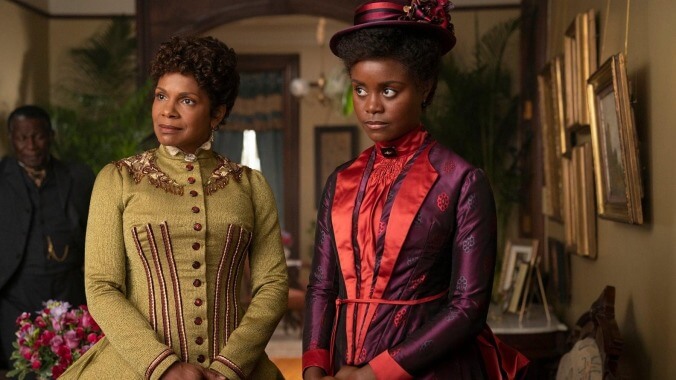The Gilded Age goes to Brooklyn and makes a little history
“A Long Ladder” reveals more about Peggy's background, and how Marian is becoming the show's Achilles heel.


Agnes: I haven’t been thrilled since 1865.
This week’s episode, “A Long Ladder,” begins with the funeral of Patrick Morris as the guests whisper behind Mrs. Morris’ back about her husband taking his own life. But the real tragedy in the van Rhijn household is that Pumpkin escaped his leash and disappeared. Someone call the NYPD! It is an utter calamity, at least for Ada, and Bannister, who was foolish enough to lose the pup. Naturally, it’s the Russells who find him, giving us this week’s opening excuse for across-the-road communication. Because the show will hold out on the Agnes vs. Bertha fireworks as long as possible, we instead get a diplomatic envoy of Butler to Butler, as Church gives Bannister the grand tour. It creates yet another moment for the show to go full house porn on the Russell mansion, and I, for one, could do with this every week. (It also allows Bannister to neg on his counterpart over menu and spoons, sending the Russell downstairs into a tizzy.)
In other inter-61st street dealings, Harry wasn’t quick enough off the mark to see Oscar’s game with Gladys, but George is. Bertha might jump at such a match, but George is less thrilled, especially since Oscar looked to drop them during last week’s Great Train STONKS. But Oscar will have to wait, as George and his secretary, Richard Clay (Patrick Page), have Grand Central, Jay Gould, and JP Morgan to consider. For all that Russell’s ruthlessness won him the day, he knows this is not the way. It’s time to make a deal and help Fane recover his losses. In exchange, he would like the Charity Women Esq. to get in line with bringing Bertha into society.
Fane is the lever Russell has, but Aurora’s not wrong that she’s not the one he needs. He needs Mrs. Astor, so she sets about working Bertha up the chain, starting with an invite to the symphony fundraiser for the Red Cross, which she has already also invited Marian to see, meaning the two will sit together before the hour is out.
Before we deal with Marian, after last week’s run at a white newspaper, Peggy has set her sights on the doable. She’s heading to The New York Globe, one of the most famous Black newspapers of the era. The Globe’s editor, Mr. Fortune (Sullivan Jones), has asked for a meeting. It’s a total meet-cute over the printing press. Suddenly, Peggy isn’t just writing fiction—Fortune commissions her to put down 200 words on voting rights for women too.
Surprisingly, Agnes is not nearly as horrified as expected by this development as one might expect. However, she insists on being kept in the dark about the political article’s contents. She’s also not wrong to tell Peggy to keep that part of the news under her hat when she heads over to Brooklyn for a visit. The Scotts will love to hear their daughter is being published, but her father would not take well to her being a pot-stirrer.
And now let us pause and marvel at one of the rarest sights in all of period drama: A Black American middle-class family, complete with faithful servants, dining in their home. This scene is an utter delight. By the time they’ve finished their crab dishes, I would take an entire series focused directly on Mama Scott and her wayward daughter, Peggy, and all about the drug store. Also, can we talk about that brownstone? (Can we talk about Marian’s face when she saw that brownstone? Girl should have taken those shoes, gotten back in the carriage, and rode home right then and there.) And that, my friends, is when we get our second moment I never thought I’d see in a period piece. A callout of the clueless privilege of white ladies and a harsh reminder to Marian that Peggy Scott has not now or ever been her equal or her friend, no matter what she’d like to pretend. (Even Sanditon never had the nerve.)
How do you solve a problem like Marian? It’s like Julian Fellowes is convinced an American accent must mean innocent smiles and sunshine. It’s just not cutting it. Give me the silent repressed frustrations of Ladys Mary, Edith, and Sybil, or GTFO. It was forgivable when Marian was still new in town, and it rings super true in Brooklyn. However, the rest of the episode falls flat. Marian should know by now talking to Mrs. Chamberlain is an absolute social no-no, and the continued insistence on playing her as a wide-eyed innocent does the character no favors. It seems almost fitting Mrs. Chamberlain’s present arrives in front of Agnes and Ada, raising Agnes’ suspicions that someone unsuitable (aka Raikes) is courting her niece. Well, someone is.
Naturally, Marian does not listen to Ada, going inside the Chamberlain townhouse, giving us a look at the inside of a gorgeous palatial sitting room and that stunning gallery full of paintings and sculptures. (We also finally learn what her social crime was. She was Mr. Chamberlain’s mistress, who he married when the wife died. Considering the Turners of the world are living downstairs, no wonder she’s shunned.)
As for the final scene at the symphony, at least Agnes will have multiple things to rail about, as Marian not only earnestly befriends Bertha, but Raikes shows up. (How hard is Raikes engineering these friendships to chase Marian? I know he is supposed to be as wide-eyed innocent as she, but I secretly want him revealed as the most ruthless social climber of them all.) But when it comes to this wide-eyed romance, I’m with Mrs. Russell—if the kid doesn’t have money, he’s not going to be able to keep up this lifestyle. Marian can be as innocent as she wants, but you do not marry a man who thinks nothing of that kind of debt.
Stray Observations
- Grand Central Depot was actually built in 1871 by the Vanderbilts. There was behind-the-scenes wheeling and dealing; it was over the Hudson River Bridge.
- Timothy Thomas Fortune was a real groundbreaking Black journalist, and the history he cites is accurate.
- Ms. Grant, we hardly knew ye!
- Bloomingdale Brothers was founded in 1861 as a hoopskirt store. It moved to 59th St in 1886 and became Bloomingdale’s.
- Several pieces in Mrs. Chamberlain’s collection will be recognizable to art lovers; it’s a veritable feast of art history Easter eggs.
- I thought at first George was talking about the Borki Rail Disaster, which would have been anachronistic, as it didn’t occur until 1888, but the number of dead reveals it was the Tcherny railway accident in 1882.
- Like Mrs. Astor, Ward McAllister was an actual member of the Four Hundred, and I cannot wait to meet him.
- Bridget seems a nice enough girl, but the only thing worth its salt from downstairs this week was watching George throw Turner out of his bedroom.
- I was going to give dress of the week to Bertha’s white silk gown with blue feathers and chiffon collar. But then That Red Dress happened with the matching cloak, trumping everything that’s come before. Consider it the current favorite for Outfit Of The Season.